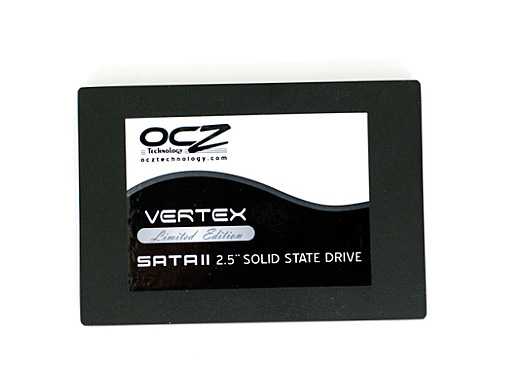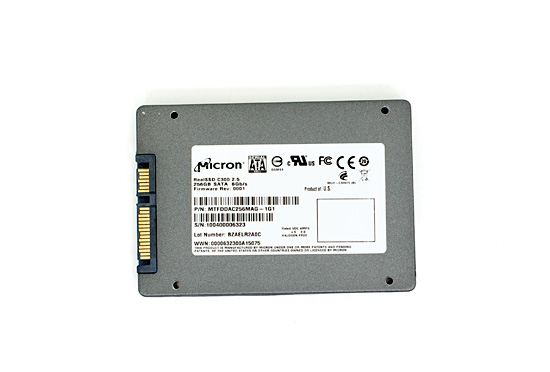OCZ’s Vertex Limited Edition Review & SSD State of the Union
by Anand Lal Shimpi on February 19, 2010 12:00 AM EST- Posted in
- Storage
Final Words
If you were one of the first customers to buy an X25-M G1 or G2, these new drives are fast but not fast enough to make you want to ditch your drive. At the same time, if you’re looking to make the jump to what I’ve often referred to as the single best upgrade you can purchase for your PC, these new drives don’t do anything to lower prices. At $399 the 100GB Vertex LE is no better of a deal than the existing Indilinx offerings. The $499 Crucla RealSSD C300 takes price in the wrong direction as well. If you were waiting for SSDs to get cheaper, you’ll have to wait even longer for the transition to 25nm MLC NAND flash in Q4.
That being said, there is value to be gained from today’s announcement. At $399 you are getting more SSD for your money than you will be able to get when the SF-1200 based Vertex 2 drives ship later this year. The only unknown is how much performance you’ll give up by going to a cheaper SF-1200 drive. I've heard that the maximum read/write speed of the SF-1200 will be similar to the SF-1500, but random performance is unknown at this time. Ultimately how much worse the SF-1200 performs will dictate how valuable the Vertex Limited Edition actually is.

Make no mistake - the Vertex Limited Edition is fast. Easily faster than the SSD posterchild Intel’s X25-M, across the board. It’s only in our heavy multitasking/downloading workload that the SandForce’s controller shows its soft spot. When tasked with a great deal of compressed writes, the SF-1500 controller performs no better than last year’s Indilinx Barefoot. At least with the Vertex LE you’re not paying a price premium for it.
The Vertex LE boasts sequential performance that easily hits the limits of 3Gbps SATA. Doing so with reads isn’t that hard, but with writes it’s harder to do. Granted anything you’re writing that’s large enough to transfer at speeds of 250MB/s for more than a couple of seconds is likely highly compressed to begin with and thus you won’t see those transfer speeds to begin with. Such is the great paradox of SandForce’s DuraWrite technology.
Unlike most drives that only offer good sequential performance, the Vertex LE doesn’t use it as a crutch. Random read and write performance is spectacular, regardless of OS or partition alignment. Under Windows 7, the Vertex LE can randomly write data in 4KB at 162.2MB/s. That’s faster than Intel’s X25-M G2 can write sequentially.
Then we have Crucial’s RealSSD C300, which you are paying a price premium for. Starting at $499 the C300 commands a higher price than any other SSD on the market with 128GB of MLC NAND flash. As a result you get the only 6Gbps compatible SSD on the market, and the performance to back it up.

At first glance it is the most Intel-like of any of the SSDs here. Its performance comes without any stipulations as to the type of writes you have to be doing, it just always delivers.
Sequential and random performance is stellar, although out of the box it doesn’t deliver the best performance under Windows XP. Pair it with a more modern OS that is 4K-aware and its performance easily rivals the SF-1500. Give it access to a 6Gbps SATA controller and it’ll deliver higher sequential read speeds than we’ve ever seen from an SSD.
The RealSSD C300’s random write performance under Windows 7 is slightly behind the Vertex LE, but its random read performance is much better.
Real world performance of the C300 is nothing to scoff at. It’s easily in the top 3 of all SSDs we’ve ever tested, and arguably the fastest MLC SSD on the market. Especially if you pair it with a 6Gbps SATA controller. The only thing that worries me about the C300 is its unusually high max write latency. Admittedly it pokes its head up very rarely and average write latency is second only to the Vertex LE, but OSes don’t always respond well to unexpectedly high write latencies. It’ll be something to keep an eye on as I get more time with the C300.
Our final newcomer is the Kingston SSDNow V+ Series drive. Priced at $399 it continues the trend of not driving prices lower, just offering alternatives. The 128GB drive I tested performed extremely well in some cases such as our heavy multitasking/downloading Bench workload. In others, the drive was much less impressive. The Toshiba controller doesn’t do well in random write performance, mimicking the Samsung RBB controller it often competes with in OEM machines. The fact that I wasn’t able to get TRIM working is also cause for concern. If Kingston could drop the price on the drive and get the TRIM support working it might be an interesting alternative to Samsung based drives.
Now we get to the hard part, recommendation time.
There’s this convergence of SSDs with 128GB of NAND at the $399 price point. Generally at or around $399 you can get something with 128GB of NAND. Controller offerings at this price point are Indilinx, Intel, Samsung and now SandForce.
Assuming the drive is totally reliable, and there’s no chance of any bugs creeping up that OCZ/SandForce missed, the Vertex LE would be the absolute best buy at $399. You’ll notice that my recommendation comes with a huge caveat. The last SF-1500 drive I had died after two weeks. Admittedly it was a beta, but this is also SandForce’s first drive shipping to consumers ever. I think it’s more than fair to be cautious.
If you’re willing to take the risk, the Vertex LE appears to be the best SSD you can buy at $399. It is a difficult proposition simply because we have had such limited experience with the drive and the controller/firmware have a completely unproven track record. It really boils down to how much of an early adopter you are. At least OCZ as a company tends to take care of its customers, so even if you do take the jump and something does go wrong you won’t be SOL. The Vertex LE will ship with a 3 year warranty and if your drive dies you'll get another LE (OCZ is putting some aside), Vertex 2 or other equivalent in its place.
OCZ’s CEO Ryan Petersen and I could always get into another yelling match if you aren’t taken care of.

If you're not willing to risk it, Intel or Indilinx are your best bets. Intel for best random performance, or Indilinx for better sequential write speed and cost.
Go up another $100 and the recommendation is easily the Crucial RealSSD C300. Again, assuming that nothing horrible ever happens with the drive. I do have more faith in Crucial’s validation testing given that Micron is shipping the same drive to OEMs, but it’s still a brand new, unproven platform. It is good to see Crucial/Micron actually embracing new technology instead of shying away from it. The combination of ONFI 2.0 NAND and 6Gbps SATA give the C300 an advantage that no other drive can match.
It's the price point that I'm really not comfortable with. When Intel launched the X25-M at nearly $600, it was fine because no other drive came close. With real world performance of the C300 virtually indistinguishable from the competition, it's difficult to justify that extra $100. Granted in more I/O bound cases, the C300 does have some extra value - I just question whether or not that's worth an extra $100.
While performance is surely improving, price is not. We'll have to wait until Q4 for that. The fact that Intel's roadmaps show the X25-E using 34nm MLC NAND means things are going to get very interesting for enterprise SSDs in 2011.










83 Comments
View All Comments
AnnonymousCoward - Sunday, February 21, 2010 - link
> Zoomer: The point of SSDs is to improve the user> response time.
Exactly! So why don't we compare response times?
> erple2: Saying that one drive attains 600 IOPS on
> "Anand's light StorageBench" where another
> attains 500 IOPS _ON THE SAME BENCHMARK_ does, in
> fact, give you a reasonably accurate comparison.
Sorry, not true. Like I said, SandForce's compression makes IOPS not equal to bandwidth. See http://tinyurl.com/yden7kc">http://tinyurl.com/yden7kc . And allow me to restate my comments from the last article: In article http://tinyurl.com/yamfwmg">http://tinyurl.com/yamfwmg , in IOPS, RAID0 was 20-38% faster! Then the loading *time* comparison had RAID0 giving equal and slightly worse performance! Anand concluded, "Bottom line: RAID-0 arrays will win you just about any benchmark, but they'll deliver virtually nothing more than that for real world desktop performance."
So there you have it. Why measure IOPS?
> erple2: what is important is the general ranking
> of these devices in the same benchmark. The
> benchmark is measuring the _relative_ performance
> of each of the drives in the same sequence of
> tests.
What "general ranking" lacks is the issue of significance. I apologize, but I will again restate what I posted on the last article: is the performance difference between drives significant or insignificant? Does the SandForce cost twice as much as the others and launch applications just 0.2s faster? Let's say I currently don't own an SSD: I would sure like to know that an HDD takes 15s at some task, whereas the Vertex takes 7.1s, the Intel takes 7.0s, and the SF takes 6.9! Then my purchase decision would be entirely based on price! The current benchmarks leave me in the dark regarding this.
jimhsu - Saturday, February 20, 2010 - link
The performance/free space dropoff is a significant issues, especially with otherwise-fast SSDs (i.e. Intel). For example, the 80GB X25-M should really be relabeled as a 60GB drive due to progressive worsening performance as the amount of free space decreases (beyond 70GB, it starts getting REALLY bad). Do these drives show any improvement in the performance to free space degradation curve?Demon-Xanth - Saturday, February 20, 2010 - link
Given the state of so many SSDs out there using so many controllers with the performance being so dependent on the controllers......if is possible to get "summary" chart of what drives use what controller configurations?
yottabit - Saturday, February 20, 2010 - link
Thought I would point out that Page 8's title lists "Apricon" instead of "Apricorn"As always, thanks for great articles Anand!
aarste - Saturday, February 20, 2010 - link
I'm building a new PC soon and was going to buy another Agility 60 and use it with my existing 60gb agility and raid0 them up. But since the Intel X25-M 80GB is almost the same price, and blows away the agility in random reads (which is more relevant in OS/App usage than sequential speed, correct?) would it be better just to buy and run the single Intel drive instead?I'm not too fussed about losing out on 120gb of capacity in raid0, and besides, I can install the games to the Agility instead, and use the Intel for the OS/Apps.
leexgx - Saturday, February 20, 2010 - link
No TRIM support in RAID so the drives would end up like 1 or less SSD speeds, SSDs really tank in speed once the drive has to erase before Write (Filled State)need to use Standard AHCI drivers (install win7 but do not install chipset drivers or Intel matrix drivers as that would disable TRIM)
1 intel SSD 80gb and the Agility 60GB with updated Firmware one you got now is the best option
(correct about random reads and Writes the intel one hardly drops in speed at random Writes at all, most get to Focused on sequential speeds, as long as TRIM support is there)
cjcoats - Saturday, February 20, 2010 - link
The one thing missing is the one that's really relevant to me: workstation performance.It's probably close to the "heavy load" scenario", but... For me, it's a mix of compiles, compute-intensive modeling, visualization, and GIS use. Of these, the compiles, the visualization, and the GIS are the really-interactive items, so are probably most important.
There are lots of compile-benchmarks out there; it would be relatively easy to generate a GIS benchmark, using some of the GRASS GIS logs I have from what I've been doing lately.
FWIW.
NeBlackCat - Tuesday, February 23, 2010 - link
I completely agree that there should be a developers benchmark, and keep mentioning this when these articles appear.Compiling a large software project seems to me to be a good general purpose test. There'll be random and sequential reads and writes, of a few bytes to many megabytes, in some hard to predict ratio, as the build process reads sources/headers, uses temporary files and writes output. It isn't obvious to me whether the Intel or the Indilinx/Micron characteristics would be favored.
But afaik no-one's studied this from an SSD angle, and I wish Anand would at least add a benchmark which could, say, build a Linux distro while grepping it repeatedly for some random text.
What say you Anand?
OfficeITGeek - Saturday, February 20, 2010 - link
Anand,As always another great article. I just wanted to say that it is looking really bright for SSD's. The performance benefits of SSD's are just to great to ignore (unlike the switch from DDR2 to DDR3). But I am going to hold off though until Q4 as by then, the market will have alot more competition (hence lower prices), bugs will be sorted out and the thought of dead drives (such as the one you experienced) just gives me the creeps even if they do replace it with a new one.
MadMan007 - Saturday, February 20, 2010 - link
Anand, it is getting hard to keep track of different SSDs, which controller they use, how many flash chips, etc. It would be wonderful if you could start an 'SSD decoder ring' chart that lists the relevant information, maybe even linked to performance numbers like you've done with CPUs.